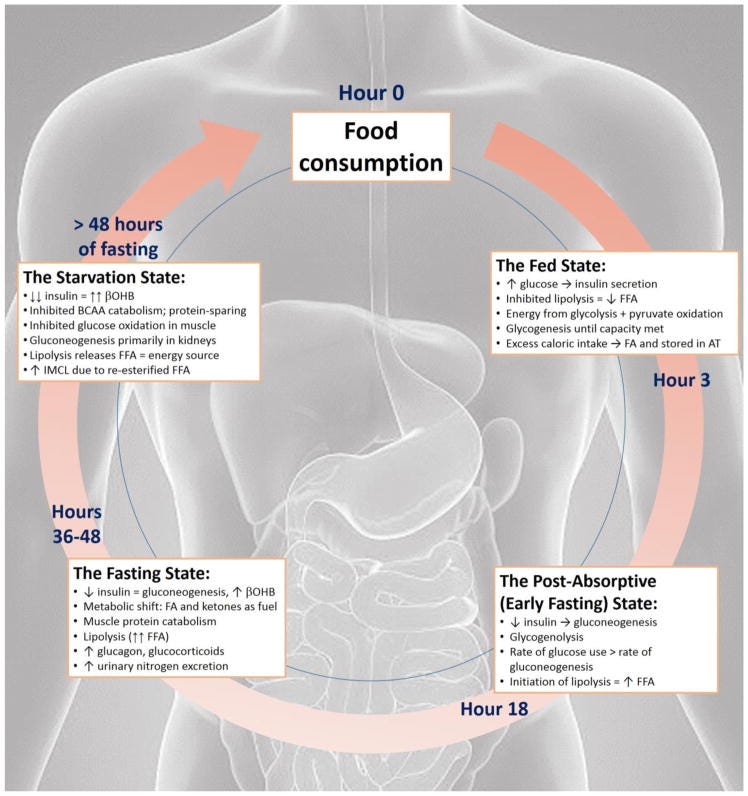What Actually Happens to the Body During Intermittent Fasting?

The Biology of Intermittent Fasting, Step-By-Step
Over the past several years, intermittent fasting has emerged as a huge trend, not just for weight loss, but also for general health and well-being.
But how does it work — what actually happens to the body during a fast that helps us lose weight and stay healthy? In this post, we’ll talk about the biology of fasting, and walk through what actually happens in the body during a fast step by step.
Fuel for the Body: Glucose vs. Fatty Acids
To understand what happens to our bodies during intermittent fasting, we need to understand a bit about how the body uses energy. The main source of energy during the day, when we eat on a “normal” schedule, is glucose, also known as blood sugar. A secondary source of energy is from fatty acids, but their use is inversely correlated with glucose levels. In other words, glucose and fatty acids “compete” for use as a fuel in our bodies in a process known as the “glucose-fatty acid cycle”.
Because fatty acid oxidation rises only as blood sugar levels fall, it typically means that our bodies only switch to significant levels of fatty acid use after long periods of not eating. For people following a normal diet, this occurs mostly during sleep.
Blood Sugar and Insulin
Insulin is a hormone that helps make use of glucose as an energy source, and is released whenever we eat. But with consistently high levels of glucose in the blood (alongside other risk factors), the effects of insulin can be diminished in a process known as insulin resistance. Consistently high levels of blood sugar and increased insulin resistance are very unhealthy — there are many serious health issues that are related to blood sugar levels and insulin sensitivity, including obesity, type 2 diabetes and cardiovascular disease.
By putting our bodies into the “fat” part of the glucose-fatty acid cycle more frequently and for longer durations, we can lower blood sugar levels and improve insulin sensitivity, and in turn see improvements on the wide variety of health outcomes, including the big ones mentioned above: obesity, type 2 diabetes and cardiovascular disease. Intermittent fasting helps us lose weight and achieve these improved health outcomes by keeping blood sugar levels low for more of the day and keeping us in the fasted, high fatty acid metabolism state for longer durations.
If you’ve heard people talking about a keto diet, some of this might sound familiar. Practitioners of the keto diet achieve a similar effect by eating on a more normal timeline, but by greatly restricting carbohydrate intake with a diet high in fats and proteins. In fact, depending on the exact fasting schedule, some intermittent fasting routines may put the body into ketosis for short periods. Though the eating habits of a keto dieter and an intermittent faster might look very different, they’re actually achieving similar effects!
The Stages of Fasting
So with the background on the biology of glucose and fatty acids, what actually happens during intermittent fasting? What are the stages of the glucose-fatty acid cycle that our bodies go though?
As we walk through the phases of fasting, note that while we talk about them as distinct phases, it’s really a continuous process. So for example, though we talk about ketosis happening in the “fasting” phase, it can in fact already start in the “early fasting” phase, but to a lesser extent. Furthermore the exact effects and timelines are highly variable (like most nutrition issues) based on what we eat, when we eat it, exercise, genetics, gut microbiota, etc.
With that said, let’s look at different stages of fasting!

Food Consumption
This stage of the cycle is straightforward and familiar: eating food. Whenever we eat a meal, we bring macronutrients into our bodies which starts the clock on rest of the process outlined below.
Fed State (Absobtive)
This stage of the cycle, which occurs for 2–4 hours after eating a normal meal, involves a rise in blood sugar and other nutrients from the food being digested. As a result of the elevated blood sugar, insulin secretion is increased which helps body tissue to use the glucose as the primary fuel. The body also turns excess blood sugar into glycogen, which is a form of sugar thar can be stored in the liver and can be converted back to blood glucose for energy metabolism as needed, or as fat.
Early Fasting (Post-Absorbtive)
Starting about 4 hours after eating, the body enters an early fasting stage in which circulating blood sugar and insulin levels begin to drop. The body will begin converting stored glycogen back into glucose to use as energy as the circulating blood sugar is used up. Through this stage of the cycle, glycogen levels drop and there is a gradual shift to fatty acids as an energy source in a process known as lipolysis. This process can in fact only occur when insulin levels start to drop.
Fasting State
Starting about 18 hours after eating, the glycogen levels in the liver are almost entirely depleted and the body relies almost entirely on fatty acids metabolism for energy. In this phase, the body begins to enter ketosis as mentioned previously.
Depending on which form of intermittent fasting schedule you follow, you may reach this phase but not spend a significant amount of time in it. Again, because these states are somewhat continuous, you’ll likely still experience some of the early benefits of this stage even if you don’t spend a significant duration of time in this phase.
Long-Term Fasting / Starvation State
In this phase, which begins after about 48 hours without eating, ketosis continues and ketones become the main fuel for the energy needs of major organs such as the brain and the heart. Note that if you’re doing a typical daily time-restricted feeding schedule, like 16:8 intermittent fasting, you’ll never actually enter this phase. While some people do practice longer, multi-day fasts, they’re an entirely different approach which requires separate research.
Why does the cycle matter?
Now that we’ve the stages that fasting puts the body through, let’s look at why it’s important. Here are some of the benefits that research has found to various fasting schemes (including but not limited to a daily IF schedule). All of these results presentsed here are summarized and discussed in two scientific review articles: one on the general effects of IF, and the other specifically looking at potential for treatment of diabetes.
Weight Loss and Increased Fat Oxidation
This is one of the most straightforward benefits of intermittent fasting — by spending more time in the fasting state, the body increases fat oxidation and helps people lose weight.
There is some discussion in the literature of whether intermittent fasting is “just” calorie restriction, i.e., it only helps people lose weight because it reduces calorie intake. This question even led some to incorrectly state that there is “no benefit to intermittent fasting”. It’s an interesting question, but largely moot: intermittent fasting does help lose weight, has other benefits we’ll discuss below and appears easier to adhere to than other diets. So even though the mechanism of IF on weigh loss is lowered caloric intake, it’s still effective & superior to many alternative approaches!
Improved Insulin Sensitivity & Potential for Treatment of Type 2 Diabetes
As mentioned earlier, consistently high glucose levels in the blood can lead to increased insulin resistance and eventually type 2 diabetes. There is some evidence, though, that intermittent fasting, by reducing glucose levels for long periods of time, can help reset insulin resistance and improve insulin sensitivity. Though more research is needed to fully determine its efficacy, there is evidence to suggest that intermittent fasting could be used as a treatment strategy for type 2 diabetes.
Increased “Satisfaction and Fullness”
Some research has shown that individuals practicing IF exhibit more “satisfaction and fullness” compared to control subjects following a calorie restriction diet. This is important because compliance is one of the most challenging aspects of weight loss interventions. The fact that intermittent fasting is a simpler and easier habit to follow than other diets is a huge benefit, even if weight loss is comparable.
Cardiovascular Benefits
Studies show that intermittent fasting has positive effects on many indicators associated with cardiovascular health such as C-reactive protein, LDL and total cholesterol levels, and blood pressure. Though more research is needed, there are indications that intermittent fasting routines could lead to lower levels of coronary artery disease.
Putting it all together
So to put it all together, intermittent fasting puts the body through a number of physiological changes compared to a normal eating schedule. These changes are beneficial not only in terms of losing weight, but also in a number of other health outcomes.
While there are many different approaches to eating healthy and losing weight, the biology of intermittent fasting has a number of unique features that make it an excellent choice.